Rebecca’s Recipe of the Week: Courgette in a Hot Pan
‘A zucchini and a steak may not have much in common, but, like steak, zucchini takes incredibly well to the method of quickly searing in a smoking hot pan’. So states Lidey Heuck in the New York Times, and she’s right. In this easy recipe courgettes are cooked fast to develop an appetising char, and then basted with butter, garlic and rosemary. We ate these topped with ricotta, alongside a tomato salad and some good bread.
Pan-Seared Courgettes
Serves 2-3
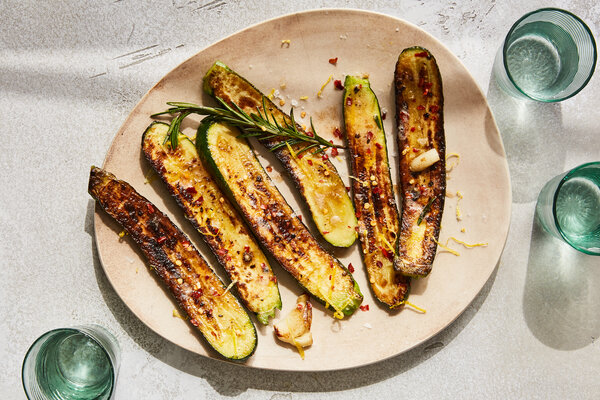
Ingredients
3 small courgettes (6 to 8 inches each)
1 tablespoon grapeseed, safflower or other high-heat cooking oil
salt and pepper
1½ tablespoons unsalted butter, or more to taste
1 garlic clove, peeled and smashed
1-2 tablespoons fresh rosemary, chopped
To garnish:
coarse sea salt
lemon zest
red-pepper flakes
Preparation
Trim the ends off the courgettes and cut them lengthwise into planks about ½-inch thick. Pat them dry, pressing gently but firmly on both sides to absorb any moisture.
Heat a large (12-inch) cast-iron or stainless-steel skillet over medium-high. If you have a ridged pan this is a good opportunity to use it. Add the oil and heat until it’s almost smoking.
Add the courgettes to the pan and press lightly with a spatula so that the planks make contact with the pan. Don’t crowd them—if you do they will steam rather than sear.
Sprinkle the tops with salt and pepper, and cook for about 3 minutes, until the courgettes are nicely charred on the bottom. Lower the heat to medium, flip over the courgettes, and season again with salt and pepper. Cook for 2 to 3 more minutes, until the bottoms are charred.
Turn the heat to low and add the butter, garlic and rosemary. Carefully tilt the pan, letting the garlic and rosemary cook in the butter for 30-60 seconds, until the butter has begun to brown. Spoon the butter over the courgettes, and cook for another minute, flipping them a few times to coat both sides with the butter.
Transfer the courgettes to a serving platter, along with the garlic and rosemary, and spoon any butter that’s left in the pan on top. Garnish with sea salt, lemon zest and red-pepper flakes, and serve hot.
Recipe adapted from New York Times Cooking
Rob’s Recipe of the Week: A slow burner
This week I made green fermented hot sauce so I thought I would share the recipe. It’s a bit of a slow burner (excuse the pun) in that it won’t be ready to eat until next summer, but it’s a fun little project so bear with me…
Green fermented hot sauce
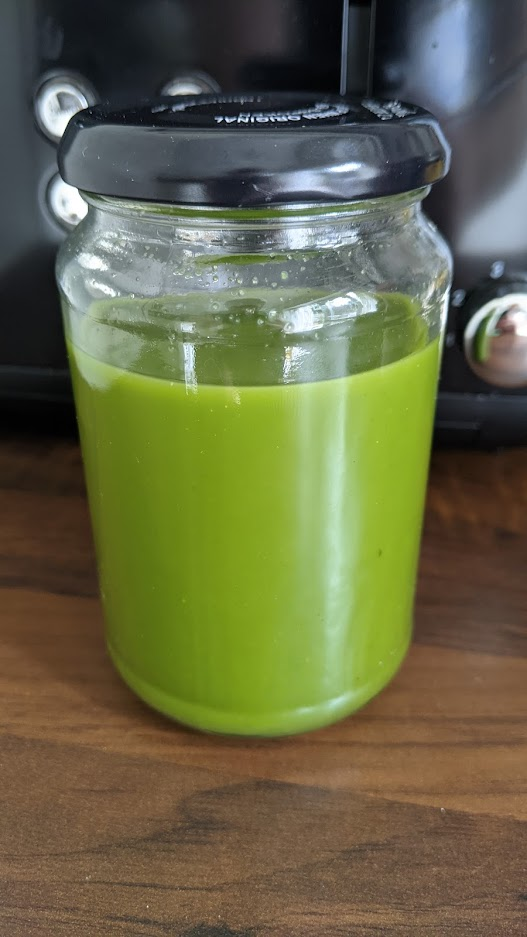
Ingredients (scale to suit your harvest):
450g green chillies
4 garlic cloves, peeled and crushed
3 tablespoons salt
4 cups warm water
Method:
To make chillies:
The first thing you need to do is reserve some seeds from the dried chillies in the share, and then sow them into modules or pots inside, early in 2022, repotting as they grow. I grew 9 plants in the end, which have happily produced all summer outside. I picked chillies green to stimulate more growth and froze them until I had enough for a batch of sauce. Approx 1 month of harvest gave me 225g of chillies which resulted in 1 jam jar of sauce. Beware it’ll be very hot – Frank’s hot sauce has nothing on the Canalside chillies!
To make sauce:
Remove tops of peppers and split in half lengthwise. You might want to wear gloves for this. Tightly pack a jar with peppers and garlic, leaving a little headspace
Mix salt and warm water to form a brine and pour this to completely cover the chillies
Fill a freezer bag (or alternative) with water and use this to weigh down the chillies, keeping them submerged
Cover with a kitchen towel and leave in a cool dark spot (such as a cupboard) for 3 or 4 days or until brine appears slightly cloudy and bubbly. The longer it sits, the funkier it will get. Don’t let it go past 7 days or it will be too funked (even for you). It’s worth opening the jar every day or so to release built up air pressure.
Strain the brine and reserve it. Transfer the chillies to a high-speed blender. Add 1 cup of the reserved brine, 1 cup of fresh coriander (omit if you don’t like the taste) and 1/4 cup apple cider vinegar to the blender, and process until very smooth. Strain the pulp through a fine-mesh sieve, and bottle.
Store in the refrigerator. The flavours will continue to develop and get more complex over time, and the heat will mellow. This will keep for at least 12 months in the fridge.
Adapted from: https://www.anarchyinajar.com/blog/2020/6/green-fermented-hot-sauce
Rebecca’s Recipe of the Week: Tarragon, Warm Potatoes
Fresh tarragon is lovely with potatoes. You can augment this salad with hard-cooked eggs or olives, if you like. It’s good on its own, and also as part of a meze spread.
Warm Tarragon and Potato Salad
Serves 4 as a side dish
Ingredients
4 large waxy potatoes
1 medium red onion
zest and juice of 1 large lemon
4 tablespoons olive oil
½ teaspoon salt
several grinds of pepper
20g tarragon leaves, roughly chopped
Preparation
Put the potatoes in a pan with cold water. Bring slowly to the boil and then simmer gently over very low heat until tender. Depending on the size of your potatoes this could take between 30 and 45 minutes. Drain and set aside.
While the potatoes cook, peel the onion and slice it fine. Put the slices in a small bowl and toss with a pinch of salt and a squeeze of lemon juice. Let sit for 10-30 minutes; this will temper the onion and make it less pungent.
Now prepare the dressing: put the lemon zest, remaining lemon juice, olive oil, salt and pepper in a jar and shake vigorously to combine. Taste and add a bit more salt or lemon juice if it’s not to your taste.
Once the potatoes are cool enough to handle but still warm, peel them (if you don’t like the peel) and then cut them into 2cm cubes. Toss them with the dressing and tarragon, and stir in the tempered onion. Eat while warm.
Recipe adapted from Sally Butcher, Persepolis (2011).
Rob’s Recipe of the Week: Quick tasty salad side
This is a bit of a summer favourite for getting a quick hit of refreshing and flavorful nutrition alongside the rest of lunch. It’s easily adaptable to personal taste by adding things like feta cheese, so make it your own!
Ingredients
Cucumber
Red onion or shallots
Tomatoes
Black olives
Lemon juice
Olive oil
Salt
Method
Finely dice equal parts cucumber onion and tomato. Mix and add some diced olives, a splash of lemon juice a dash of salt and a good helping of olive oil.
Rebecca’s Recipe of the Week: Too Hot to Cook
Diana Henry includes this light and uplifting dish in a menu she calls ‘Too Hot to Cook’, which is exactly what it is right now. In truth the recipe involves a bit of cooking, since you have to sauté the carrots and beetroots, but only for about 2 minutes total, so it’s not too taxing. This is particularly good with the small, tender Canalside carrots we’re getting just now. She observes that ready-cooked beetroot is perfectly fine. (Just avoid the ones in vinegar.) Her version is a bit more elaborate insofar as it involves straining the yoghurt through a cloth for a few hours to make it a bit thicker before you mix it with the herbs and other seasonings. You can do that if you want.
In case you’re curious, the rest of her menu consists of roast tomatoes, fennel and chickpeas with preserved lemons and honey, and, for pudding, cherries in wine, with cardamom cream and rose pistachio shortbread. Yum!
Beetroots & Carrots with Cumin and Yoghurt
serves 4-6 as a starter
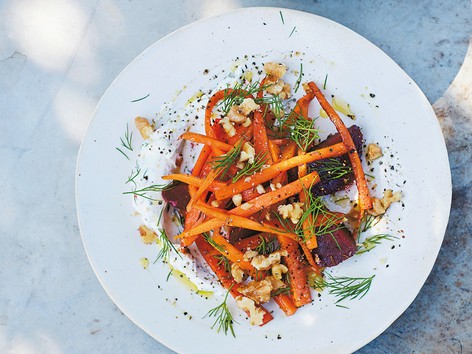
Ingredients
400g plain (full-fat) yoghurt
4 tablespoons olive oil
15g dill or coriander, roughly chopped
2 garlic gloves, peeled and crushed to a paste with a little salt in a mortar and pestle (optional)
¼ teaspoon Aleppo pepper (or to taste)—or use part of a chopped Canalside chile pepper
800g carrots
600g cooked beetroot
2 teaspoons cumin seeds
½ tablespoon white balsamic vinegar
½ lemon
25g walnuts, lightly toasted (optional)
Preparation
Mix the yoghurt with 2 tablespoons olive oil (i.e. not all of it!), most of the chopped herbs (keep a little back for a garnish), the crushed garlic and pepper. Swirl the yoghurt over the bottom of a serving plate and set aside.
Peel the carrots and cut them into thin matchsticks. Peel the beetroot and cut into slim wedges.
Heat 1 more tablespoon of olive oil in a large frying pan over medium heat. When it’s hot add 1 teaspoon of cumin seeds (i.e. not all of them!) and sizzle for about 30 seconds, then add the carrots. Stir-fry for about 1-2 minutes, or until they lose their rawness but still have some crispness to contrast with the soft beetroot. Add the white balsamic vinegar and a generous squeeze of lemon juice and season to taste with salt and pepper. Transfer to a bowl and return the pan to the heat.
Add the final tablespoon of olive oil and heat up as before. Add the remaining cumin seeds and again let sizzle before adding the beetroot. Cook for about 30 seconds, until they are heated through but not hot. Squeeze some more lemon juice over the top and season to taste with salt and pepper.
Array the beetroots over the yoghurt and then spoon on the carrots. Sprinkle the remaining herbs over the top and garnish with the walnuts (if you’re using them). Decorate with a final drizzle of olive oil and serve.
Recipe adapted from Diana Henry, How to Eat A Peach (2018).
Rob’s Recipe of the Week: A Salad Addition
There’s a lot of salad in the share at the moment, so I thought I would share a tip I have recently adopted for bulking out salads with minimal effort – homemade breadcrumbs. Once baked they should store in an airtight container for 1 to 6 months, depending what source you believe. It’s a simple one, but very effective!
Ingredients:
Bread, ideally leftover to minimise waste (i’ve been using bread buns post BBQ)
Optional flavouring ideas (per cup of bread crumbs):
½ teaspoon salt
⅛ teaspoon garlic powder
½ teaspoon onion powder
½ teaspoon dried mixed herbs
Method:
- Break bread up into a food processor and blend until desired crumb size is achieved.
- Spread evenly on a baking sheet and bake at 150°C for 15 minutes, turning during cooking if necessary.
- Cool on baking sheet out of oven.
- Fill jar, minimising airspace and store in a cool dry place until needed (I use them most lunchtimes at the moment!)
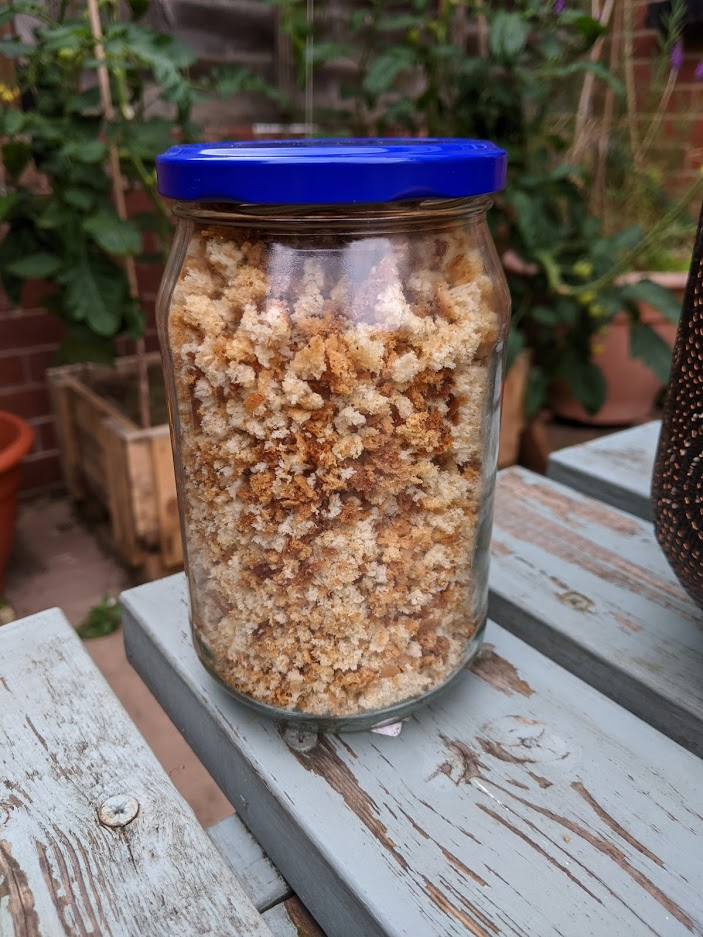
Rebecca’s Recipe of the Week: Peckham Salad
This salad is in honour of my younger son Isaac, who has moved to Peckham, home of Sally Butcher’s wonderful restaurant Persepolis. The recipe is adapted from Butcher’s 2011 Veggiestan. The combination of crispy, raw carrot and sweet, roasted beetroot works well with the orangey balsamic dressing. The original recipe includes several sweet potatoes alongside the beetroot. If you’d like to include these, peel and boil for about 15 minutes, and then toss with the other ingredients.
Beetroot and Orange Salad
serves 4 as a side dish
Ingredients
Salad
2 large beetroots
1 large carrot, peeled and grated
1 big handful of parsley, coarsely chopped (you can use all parsley or all mint if you prefer)
1 big handful of mint leaves, coarsely chopped (you can use all parsley or all mint if you prefer)
Dressing
zest and juice of 1 large orange
2cm of ginger, peeled and grated
½ teaspoon ground cumin
¼ teaspoon ground cinnamon
4 tablespoons olive oil
1 teaspoon orange flower water
2 teaspoons balsamic vinegar
salt and pepper
Preparation
Preheat the oven to 200C. Place the whole beetroot in the oven and roast for between 45 and 90 minutes, or until it is soft when poked with a fork. Remove and let cool.
While the beetroot roasts, prepare the dressing: put all the ingredients into a jar and shake vigorously until well mixed. Don’t forget to zest the orange before you cut it in half to juice it!
Once the beetroot is cool enough to handle, peel it and cut into 1.5cm cubes. Combine it with the grated carrot and chopped herbs, and then pour the dressing over and toss.
Recipe adapted from Sally Butcher, Veggiestan (2011).
Ali’s Recipe of the Week: Waste Not Want Not Pesto
With new season carrots appearing in the share for the first time this week, there’s an opportunity for an interesting way to use the fronds, saving them from the compost heap. Carrots tops have a grassy, parsley-like flavour that makes them ideal for blitzing into a quick and simple pesto. It’s sensational served with roasted carrots, spread on toast, tossed through pasta or stirred with a few glugs of olive oil to make a delicious salad dressing.
Carrot top pesto
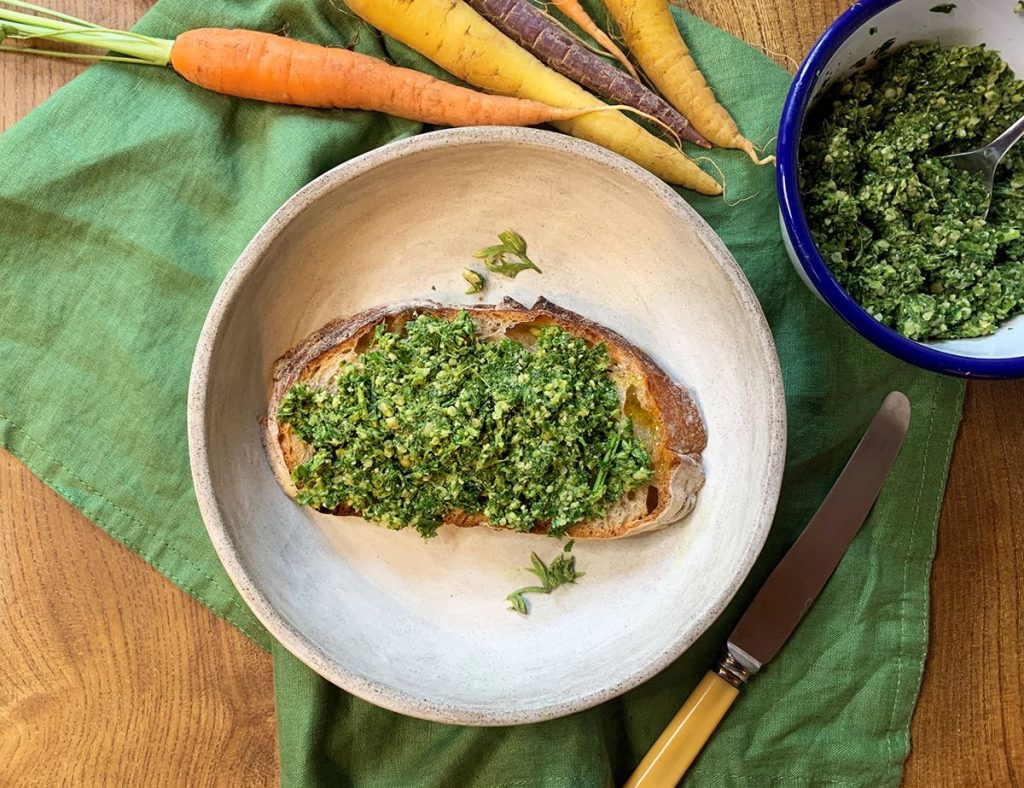
Ingredients
Bunch of carrots (tops only) – for best results discard any tougher larger stems and just use the feathery ones
½ lemon, juice only
1 garlic clove, peeled
75g cashews, walnuts or almonds
3 tbsp olive oil
Sea salt
Freshly ground pepper
Handful of grated Parmesan (optional)
Prep: 10 mins
Method
1.Trim the carrot tops off the carrots and thoroughly wash the tops to get rid of any dirt. Roughly chop them.
2.Pop the carrot tops into a food processor and add the other ingredients. Whizz till you have a coarse paste. Taste and add more salt or pepper if you think the pesto needs it. Loosen with a little more olive oil or a splash of water if needed.
3.Herb is the word: add a handful of fresh herbs to the mix, if you like. Parsley, mint, oregano and basil would all make excellent additions.
Adapted from: https://www.abelandcole.co.uk/recipes/carrot-top-pesto
Rob’s Recipe of the Week: Broad bean pasta
This recipe was a discovery late last summer and ended up being our go-to for broad beans. I’ve had it in the side-lines ever since and now broad beans are finally back, it’s time to share! This recipe was even a hit during a solid week of rain under canvas in the Lakes.
Spaghetti with broad bean pesto
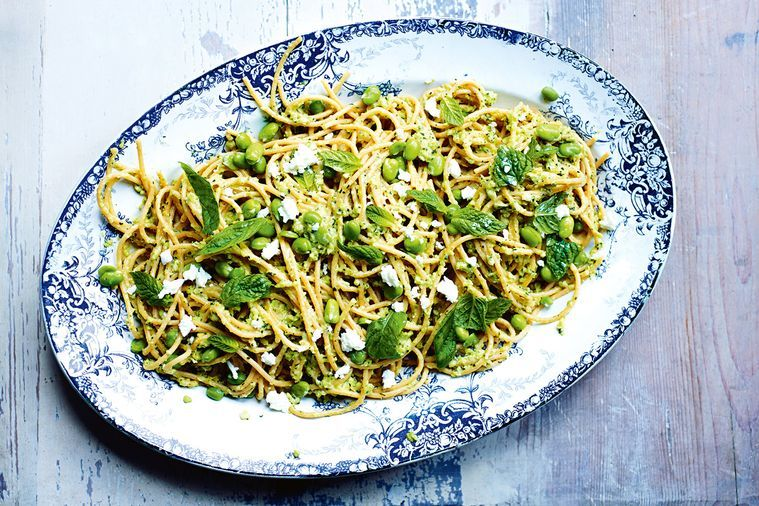
INGREDIENTS
500g dried spaghetti
500g broad beans, blanched, skins removed
1 small garlic clove
1/2 bunch mint, leaves picked, plus extra to serve
Juice of 1/2 a lemon
1/4 tsp cayenne pepper
2 tbs extra virgin olive oil
30g feta, plus extra to serve
METHOD
- Cook pasta in a pan of boiling salted water according to packet instructions until al dente. Drain, reserving a little cooking liquid.
- Whiz 200g beans in a food processor with the garlic, mint, lemon juice and cayenne. Add oil and feta, and pulse to combine (loosen with a splash of the cooking liquid, if necessary). Season.
- Working quickly, toss the drained pasta and the broad bean pesto together on a serving dish. Sprinkle with the extra mint and feta, then top with remaining beans. Serve immediately.
Recipe adapted from: https://www.delicious.com.au/recipes/spaghetti-broad-bean-pesto/Meqkhuj6
Rebecca’s Recipe of the Week: Spring Onion Dipping Sauce
Mark Bittman, whose recipe this is, writes ‘occasionally, I stumble over a culinary combination so obvious that I don’t know whether to marvel over the bad luck that has kept it from me until now or the good luck that finally brought it my way’. As recipes go, this is incredibly easy—ginger mixed with chopped spring onions, oil and salt—but it is extremely versatile. Use it as a dipping sauce for steamed chicken breast: drizzle the cooked chicken with soya sauce and sesame oil and serve with rice and this sauce. You can also stir it into plain rice or noodles, or you can eat it with steamed fish or fried tofu.
Spring onion dipping sauce
serves 4
Ingredients
4 tablespoons sunflower oil or other light vegetable oil
4 tablespoons chopped spring onions (green and white parts combined)
1 tablespoon peeled and grated ginger
½ teaspoon salt, or more, to taste
Preparation
Combine the ingredients in a bowl. Taste it, and add more salt, ginger or spring onions if you like. Spoon over steamed chicken breast or in any of the other ways described above.
Recipe adapted from Mark Bittman, The Minimalist Cooks Dinner (2001).